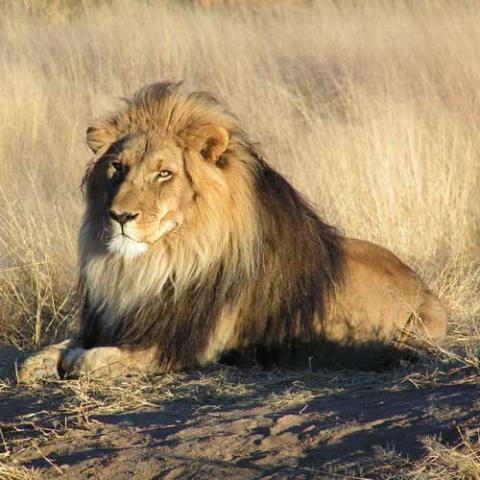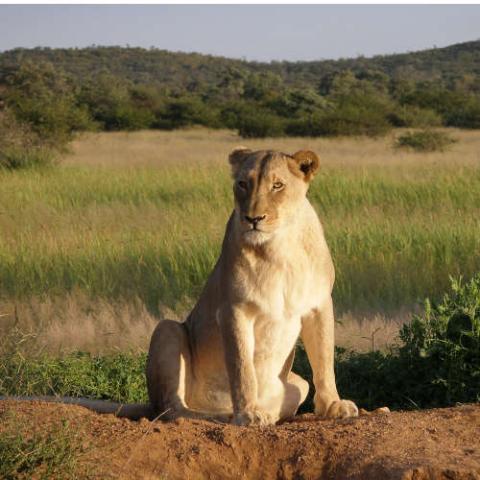NAMES
TAXONOMY
Sierra Leone
Issued:
Stamp:
Panthera leo
South Africa
Issued:
Stamp:
Panthera leo
Angola
Issued:
Stamp:
Panthera leo
Sierra Leone
Issued:
Stamp:
Panthera leo
South Africa
Issued:
Stamp:
Panthera leo
Angola
Issued:
Stamp:
Panthera leo
Sierra Leone
Issued:
Stamp:
Panthera leo
South Africa
Issued:
Stamp:
Panthera leo
Angola
Issued:
Stamp:
Panthera leo
Genus species (Animalia): Panthera leo
The lion (Panthera leo) is a large cat of the genus Panthera, native to Africa and India. It has a muscular, broad-chested body; a short, rounded head; round ears; and a dark, hairy tuft at the tip of its tail. It is sexually dimorphic; adult male lions are larger than females and have a prominent mane. It is a social species, forming groups called prides. A lion's pride consists of a few adult males, related females, and cubs. Groups of female lions usually hunt together, preying mostly on medium-sized and large ungulates. The lion is an apex and keystone predator; although some lions scavenge when opportunities occur and have been known to hunt humans, lions typically do not actively seek out and prey on humans.
The lion inhabits grasslands, savannahs, and shrublands. It is usually more diurnal than other wild cats, but when persecuted, it adapts to being active at night and at twilight. During the Neolithic period, the lion ranged throughout Africa and Eurasia, from Southeast Europe to India, but it has been reduced to fragmented populations in sub-Saharan Africa and one population in western India. It has been listed as Vulnerable on the IUCN Red List since 1996 because populations in African countries have declined by about 43% since the early 1990s. Lion populations are untenable outside designated protected areas. Although the cause of the decline is not fully understood, habitat loss and conflicts with humans are the greatest causes for concern.
One of the most widely recognized animal symbols in human culture, the lion has been extensively depicted in sculptures and paintings, on national flags, and in literature and films. Lions have been kept in menageries since the time of the Roman Empire and have been a key species sought for exhibition in zoological gardens across the world since the late 18th century. Cultural depictions of lions were prominent in Ancient Egypt, and depictions have occurred in virtually all ancient and medieval cultures in the lion's historic and current range.
Etymology
The English word lion is derived via Anglo-Norman liun from Latin leōnem (nominative: leō), which in turn was a borrowing from Ancient Greek λέων léōn. The Hebrew word לָבִיא lavi may also be related. The generic name Panthera is traceable to the classical Latin word 'panthēra' and the ancient Greek word πάνθηρ 'panther'.
Taxonomy
Felis leo was the scientific name used by Carl Linnaeus in 1758, who described the lion in his work Systema Naturae. The genus name Panthera was coined by Lorenz Oken in 1816. Between the mid-18th and mid-20th centuries, 26 lion specimens were described and proposed as subspecies, of which 11 were recognized as valid in 2005. They were distinguished mostly by the size and color of their manes and skins.
Description
The lion is a muscular, broad-chested cat with a short, rounded head, a reduced neck, and round ears; males have broader heads. The fur varies in color from light buff to silvery grey, yellowish red, and dark brown. The colors of the underparts are generally lighter. A new-born lion has dark spots, which fade as the cub reaches adulthood, although faint spots may still be seen on the legs and underparts. The tail of all lions ends in a dark, hairy tuft that, in some lions, conceals an approximately 5 mm (0.20 in)-long, hard "spine" or "spur" that is formed from the final, fused sections of tail bone. The functions of the spur are unknown. The tuft is absent at birth and develops at around 5+1⁄2 months of age. It is readily identifiable at the age of seven months.
Its skull is very similar to that of the tiger, although the frontal region is usually more depressed and flattened and has a slightly shorter postorbital region and broader nasal openings than those of the tiger. Due to the amount of skull variation in the two species, usually only the structure of the lower jaw can be used as a reliable indicator of species.
The skeletal muscles of the lion make up 58.8% of its body weight and represent the highest percentage of muscles among mammals. The lion has a high concentration of glycolytic fast-twitch muscle fibers.
Size
Among felids, the lion is second only to the tiger in size. The size and weight of adult lions vary across its range and habitats. Accounts of a few individuals that were larger than average exist from Africa and India.
Mane>
The male lion's mane is the most recognizable feature of the species. It may have evolved around 320,000–190,000 years ago. It grows downwards and backwards, covering most of the head, neck, shoulders, and chest. The mane is typically brownish and tinged with yellow, rust, and black hairs. It starts growing when lions enter adolescence, when testosterone levels increase, and reach their full size at around four years old. Cool ambient temperatures in European and North American zoos may result in a heavier mane. On average, Asiatic lions have sparser manes than African lions.
This feature likely evolved to signal the fitness of males to females. Males with darker manes appear to have greater reproductive success and are more likely to remain in a pride for longer. They have longer and thicker hair and higher testosterone levels, but they are also more vulnerable to heat stress. Unlike in other felid species, female lions consistently interact with multiple males at once. Another hypothesis suggests that the mane also serves to protect the neck in fights, but this is disputed. During fights, including those involving maneless females and adolescents, the neck is not targeted as much as the face, back, and hindquarters. Injured lions also begin to lose their manes.
Reference: Wikipedia
Photo: Wikipedia (FlickerLickr), Wikipedia (Falense), africanfreak.com






